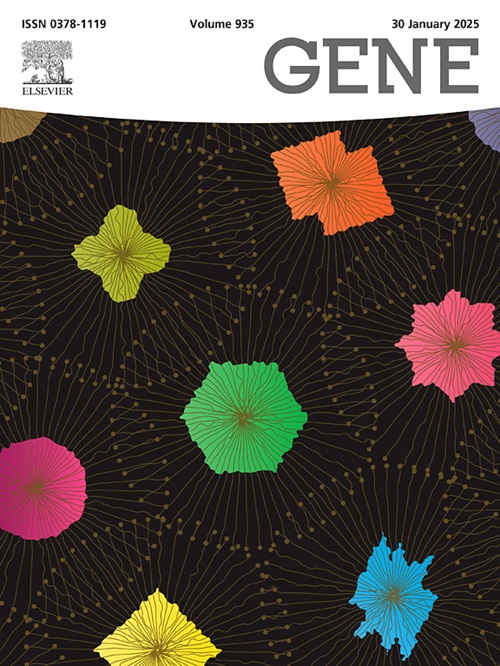FSTL3 promotes colorectal cancer by activating the HIF1 pathway
IF 2.6
3区 生物学
Q2 GENETICS & HEREDITY
引用次数: 0
Abstract
Follistatin-like 3 (FSTL3) is a glycoprotein known to promote tumor growth, invasion, and angiogenesis in various cancers. However, its role in Colorectal Cancer (CRC), particularly concerning the hypoxia-inducible factor 1α (HIF1α) signaling pathway, remains unclear. The HIF1α pathway is critical in CRC progression, enabling tumor cells to adapt to hypoxia through angiogenesis, Epithelial-Mesenchymal Transition (EMT), and metabolic reprogramming. Analysis of The Cancer Genome Atlas (TCGA) and GSE39582 datasets revealed that FSTL3 is significantly upregulated in CRC tissues and correlates with poor Overall Survival (OS), Progression-Free Survival (PFS), and aggressive features such as venous, lymphatic, and perineural invasion. In vitro experiments demonstrated that FSTL3 overexpression in HCT15 and HCT116 cells promoted proliferation, migration, and cell cycle progression, whereas knockdown in LOVO and Caco2 cells suppressed these processes and induced apoptosis. Transcriptome sequencing and western blot analysis indicated that FSTL3 activated the HIF1α pathway by upregulating HIF1α, ANGPT2, and HK3, which are key regulators of angiogenesis and glycolysis. Importantly, treatment with the HIF1α inhibitor KC7F2 reversed the oncogenic effects of FSTL3 overexpression both in vitro and in vivo. In xenograft and tail vein metastasis models, KC7F2 suppressed tumor growth, reduced pulmonary metastasis, and restored lung tissue integrity, further downregulating FSTL3 and HIF1α expression. These findings suggest that FSTL3 promotes CRC progression via the HIF1α pathway and highlight its potential as a prognostic biomarker and therapeutic target for CRC treatment.
FSTL3通过激活HIF1通路促进结直肠癌
卵泡抑素样3 (Follistatin-like 3, FSTL3)是一种已知的糖蛋白,在各种癌症中促进肿瘤生长、侵袭和血管生成。然而,其在结直肠癌(CRC)中的作用,特别是关于缺氧诱导因子1α (HIF1α)信号通路的作用尚不清楚。HIF1α通路在结直肠癌的进展中至关重要,使肿瘤细胞通过血管生成、上皮-间质转化(EMT)和代谢重编程来适应缺氧。对癌症基因组图谱(TCGA)和GSE39582数据集的分析显示,FSTL3在结直肠癌组织中显著上调,并与较差的总生存期(OS)、无进展生存期(PFS)和侵袭性特征(如静脉、淋巴和神经周围浸润)相关。体外实验表明,FSTL3在HCT15和HCT116细胞中过表达可促进增殖、迁移和细胞周期进程,而在LOVO和Caco2细胞中过表达可抑制这些过程并诱导细胞凋亡。转录组测序和western blot分析表明,FSTL3通过上调HIF1α、ANGPT2和HK3激活HIF1α通路,而HIF1α通路是血管生成和糖酵解的关键调节因子。重要的是,用HIF1α抑制剂KC7F2治疗可以在体内和体外逆转FSTL3过表达的致癌作用。在异种移植物和尾静脉转移模型中,KC7F2抑制肿瘤生长,减少肺转移,恢复肺组织完整性,进一步下调FSTL3和HIF1α的表达。这些发现表明FSTL3通过HIF1α途径促进结直肠癌的进展,并突出了其作为结直肠癌治疗的预后生物标志物和治疗靶点的潜力。
本文章由计算机程序翻译,如有差异,请以英文原文为准。
求助全文
约1分钟内获得全文
求助全文
来源期刊

Gene
生物-遗传学
CiteScore
6.10
自引率
2.90%
发文量
718
审稿时长
42 days
期刊介绍:
Gene publishes papers that focus on the regulation, expression, function and evolution of genes in all biological contexts, including all prokaryotic and eukaryotic organisms, as well as viruses.
 求助内容:
求助内容: 应助结果提醒方式:
应助结果提醒方式:


